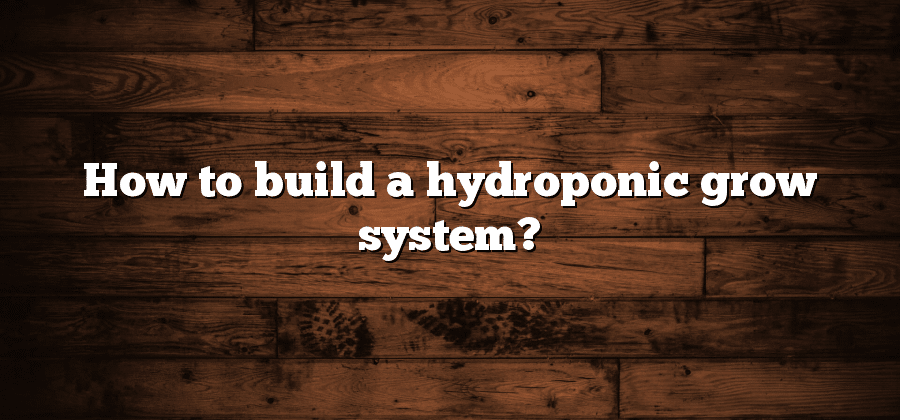Understanding the Basics of Hydroponics
Hydroponics is a soil-less method of growing plants that has gained popularity in recent years. This innovative technique allows plants to thrive by providing them with the necessary nutrients directly through water. By eliminating the need for soil, hydroponics offers numerous advantages for plant cultivation.
One of the main benefits of hydroponics is the ability to have complete control over nutrient delivery. The hydroponic system involves the use of a nutrient-rich solution that is directly provided to the plant roots. This ensures that plants receive the exact nutrients they need, in the right quantities, and at the right time. Additionally, hydroponics allows for faster growth rates and increased crop yields compared to traditional soil-based farming methods. With the basic understanding of hydroponics, you can explore the various components and techniques involved in setting up your own hydroponic system.
Choosing the Right Location for Your Hydroponic System
When it comes to setting up a successful hydroponic system, one of the most critical factors to consider is choosing the right location. The location of your hydroponic system will greatly impact its overall efficiency and productivity. Therefore, it is essential to carefully evaluate various aspects before finalizing the site.
First and foremost, it is crucial to select a location with ample access to natural light. Plants require sufficient sunlight for photosynthesis, which is vital for their growth and development. Ideally, the chosen location should receive a minimum of six hours of direct sunlight each day. Besides natural light, it is also important to consider the temperature and humidity levels of the location. Most hydroponic systems thrive in temperatures ranging from 65°F to 75°F (18°C to 24°C), with a humidity level around 50%. By ensuring the location meets these requirements, you provide an optimal environment for your hydroponic crops to flourish.
Selecting the Appropriate Grow Medium for Hydroponics
Selecting the appropriate grow medium is crucial for successful hydroponics gardening. The grow medium serves as a substitute to soil, providing the necessary support and nutrition to the plants. There are various options available for hydroponic grow mediums, each with its own advantages and disadvantages.
One common option is Rockwool, a synthetic material made from basalt and chalk. Rockwool has excellent water retention capabilities and allows for good aeration, promoting optimal root growth. Another popular choice is coco coir, which is made from coconut husks. Coco coir is lightweight and has high water retention, making it ideal for hydroponics systems. Additionally, it is resistant to diseases and pests, ensuring healthy plant growth. Perlite and vermiculite are also commonly used as grow mediums, providing good aeration and drainage for the plants.
Choosing the right grow medium depends on factors such as the type of plants you want to grow, the hydroponic system you are using, and your personal preferences. It is important to consider the moisture retention, aeration, and nutrient-holding capacity of each medium when making your decision. Experimenting with different grow mediums may be necessary to find the one that works best for your specific needs. Ultimately, selecting the appropriate grow medium is a vital step towards creating a thriving hydroponics garden.
Designing and Building Your Hydroponic Grow System
One of the key aspects of successful hydroponic gardening is designing and building a proper grow system. This involves careful planning and consideration of various factors to ensure optimal conditions for your plants. When designing your system, it is important to take into account the specific requirements of the plants you intend to grow, such as the amount of space they need, the type and intensity of lighting necessary, and the nutrient solution required for their growth.
There are several different types of hydroponic systems to choose from, including nutrient film technique (NFT), deep water culture (DWC), and drip irrigation systems, among others. Each system has its own advantages and disadvantages, so it is essential to select the one that best suits your needs and resources. Additionally, you will need to determine the size and scale of your grow system, considering factors such as available space, budget, and the number of plants you plan to cultivate. By carefully designing and building your hydroponic grow system, you can create an optimal environment for your plants to flourish and maximize their potential yield.
Installing the Necessary Equipment for Hydroponic Gardening
Hydroponic gardening offers a unique and efficient way to cultivate plants without the need for traditional soil. However, to successfully implement a hydroponic system, it is essential to install the necessary equipment. The equipment required for hydroponic gardening can vary depending on the scale and complexity of the system, but there are some basic components that are essential for all setups.
One of the key pieces of equipment needed for hydroponic gardening is a water reservoir. This reservoir serves as the central hub for the system, holding and circulating the nutrient-rich water that is essential for plant growth. The size of the water reservoir will depend on the number of plants being grown and the specific requirements of the crops. Additionally, a water pump is necessary to ensure proper circulation and distribution of the nutrient solution. This pump helps deliver the water to the roots of the plants, providing them with the necessary nutrients for optimal growth and development. Additionally, a timer can be installed to automate the pumping process, ensuring consistent nutrient delivery to the plants. As with all components of a hydroponic system, it is important to choose a pump that is appropriate for the size and demands of your setup. Overall, installing the necessary equipment for hydroponic gardening is a crucial step towards creating a successful and productive system.






